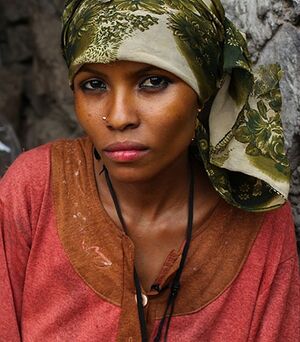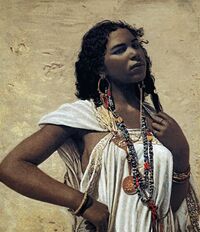Elamite people
Haltama عيلاميون عیلامیان | |
|---|---|
 An Elamite woman from Susa | |
| Total population | |
| c. 6 Million (2015) | |
| Regions with significant populations | |
| 2,732,380 | |
| c. 2.5 million | |
| c. 517 thousand | |
| c. 150 thousand | |
| Languages | |
| Elamite, Arabic | |
| Religion | |
| Shia Islam (Twelver Jafarites) | |
The Elamites (Elamite: Haltama; Arabic: عيلاميون Persian: عیلامیان) are an ethnic group of about 5 to 6 million people, with approximately half living in Elam and near its borders. They are a minority group in Iran, where they are also native, but they are also found through their diaspora throughout the middle east. The Elamites are almost entirely Shia Muslims. Culturally, linguistically, and genetically, the Elamites are distinct from their Semitic and Indo-Iranian neighbours. Although most Elamites speak the Elamite language predominantly, many are bilingual in both Elamite and either Arabic or Persian, and a small minority are monolingual Arabic speakers.
History
Origins
Genetics

Considering their NRY variation, Elamites are distinguished from neighbouring Iranian peoples by their relatively elavated frequency of Y-DNA Haplogroup R1b, specifically subclade R1b1a2a-L23. Together with its other clades, the Haplogroup R1 group comprises the single most common haplogroup among the Elamites. Haplogroup J2a (subclades J2a3a-M47, J2a3b-M67, J2a3h-M530, more specifically) is he second most commonly occurring patrilineage in the Elamites and is associated with the diffusion of agriculturalists from the Neolithic Near East c. 8000-4000 BC. Another haplogroup reaching a frequency above 10% is that of G2a, with subclade G2a3b accounting for most of this. Also significant among the Elamites is haplogroup E1b1b1a1b, originating in the horn of Africa, and which the Elamites display the highest frequency of in the Iranian plateau and Mesopotamia region. Lineages Q1b1 and Q1a3 present at 6%, and Haplogroup T appears at a frequency of 4%.
The Elamites are considered to be a continuation of the Ancient Elamites as well as other aboriginal Pre-Iranian peoples of the region, such as the Kassites and the Gutians. Michael M. Gunter states that prolonged contact and admixture has made the modern Elamites very closely related to the Kurds.
Culture

Elamite culture is a legacy from various ancient peoples who shaped the modern Elamites and their society. As in most other Middle Eastern populations, a high degree of mutual influences between the Elamites and their neighbouring peoples are apparent. Therefore, in Elamite culture, elements of various other cultures are also visible. However, as a whole, modern Elamite culture is closest to that of western Iranian peoples, in particular those who have historically had the closest geographical and political proximity to the Elamites, such as the Persians and the Kurds. Elamites, for instance, also celebrate Nawruz on the vernal equinox as New Year's Day.
Language
The identifying language of the Elamites is called Elamite, a language isolate native to the southwestern Iranian plateau and lower Tigris-Euphrates river system.
Religion
Cuisine
Women

In general, Elamite women's rights and equality have improved in the 20th and 21st centuries; generally, it can be said that Elamite women have much greater freedom than women in other groups within the region, similar to their northern neighbours the Kurds.
Dress
Islamic dress
In spite of the long and well-established presence of Islam in Elam, headscarves and veils were historically uncommon in Elam. A formal ban on all Islamic veils (including headscarves, chador, and burqas) existed from 1941 to 1980. Hijab surged in popularity during the 1980s following Islamist revolutions in neighbouring countries, particularly the 1979 Revolution in Iran, prompting the government to rescind their anti-veiling policies out of fear of a similar revolutionary backlash. For a brief period from 1996 to 2002, headscarves were compulsory for women over the age of 9, a policy which was also rescinded due to controversy and popular backlash. Unofficial data estimates that approximately 22% of Elamite women regularly wear hijab, compared to about half of Persians and over 90% of Elamite Arabs.
